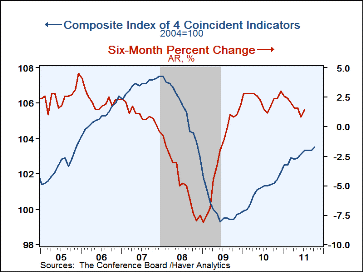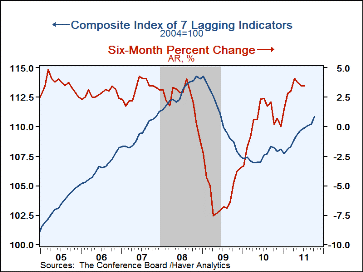 Global| Nov 18 2011
Global| Nov 18 2011U.S. Leading Indicators Are Strong
by:Tom Moeller
|in:Economy in Brief
Summary
The Conference Board reported that its Leading Economic Indicators index rose 0.9% during October following a 0.1% September rise, revised down from 0.2% reported last month. The gain beat the Consensus forecast for a 0.6% increase. [...]
The Conference Board reported that its Leading Economic Indicators index rose 0.9% during October following a 0.1% September rise, revised down from 0.2% reported last month. The gain beat the Consensus forecast for a 0.6% increase. The breadth of the latest index gain was notably wide as 90% of the components rose versus September, the most since December 2009. The rise in the index stemmed from higher building permits, a steeper interest rate yield curve, higher stock prices, stronger money supply growth, longer weekly hours worked, fewer claims for unemployment insurance and improved consumer expectations. Vendor performance provided a negative influence as the speed of deliveries quickened.
Evidence of the economy's weakness also was in the Conference Board's report. The index of coincident indicators ticked up a modest 0.2% after no change during the prior two months. Over the last six months the index rose at a modest 1.4% rate. The 1-month diffusion index of the indicators rose to 100%.
In a sign that economic excesses continued to build, the October lagging indicator index rose 0.6%, its strongest gain since April. The rise was led by more commercial & industrial loans outstanding as well as the average duration of unemployment. The ratio of coincident-to-lagging indicators, which tends to "lead" the "leaders," fell to its lowest level since February 2010.
The Conference Board figures are available in Haver's BCI database; the components are available there, and most are also in USECON. The forecast figure is the Consensus in the AS1REPNA database. Visit the Conference Board's site for coverage of leading indicator series from around the world.
The National and the Regional Economic Outlook from William C. Dudley, President and Chief Executive of the Federal Reserve Bank of New York can be found here.
Future Recession Risks: An Update from the Federal Reserve Bank of San Francisco is available here.
| Business Cycle Indicators (%) | Oct | Sep | Aug | Y/Y | 2010 | 2009 | 2008 |
|---|---|---|---|---|---|---|---|
| Leading | 0.9 | 0.1 | 0.3 | 6.6 | 7.8 | 0.3 | -3.1 |
| Coincident | 0.2 | 0.0 | 0.0 | 2.0 | 1.1 | -5.4 | -1.3 |
| Lagging | 0.6 | 0.1 | 0.2 | 2.5 | -2.9 | -1.9 | 3.1 |
Tom Moeller
AuthorMore in Author Profile »Prior to joining Haver Analytics in 2000, Mr. Moeller worked as the Economist at Chancellor Capital Management from 1985 to 1999. There, he developed comprehensive economic forecasts and interpreted economic data for equity and fixed income portfolio managers. Also at Chancellor, Mr. Moeller worked as an equity analyst and was responsible for researching and rating companies in the economically sensitive automobile and housing industries for investment in Chancellor’s equity portfolio. Prior to joining Chancellor, Mr. Moeller was an Economist at Citibank from 1979 to 1984. He also analyzed pricing behavior in the metals industry for the Council on Wage and Price Stability in Washington, D.C. In 1999, Mr. Moeller received the award for most accurate forecast from the Forecasters' Club of New York. From 1990 to 1992 he was President of the New York Association for Business Economists. Mr. Moeller earned an M.B.A. in Finance from Fordham University, where he graduated in 1987. He holds a Bachelor of Arts in Economics from George Washington University.










